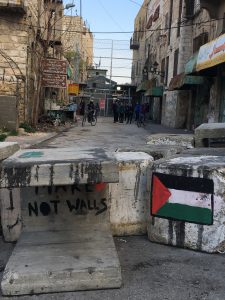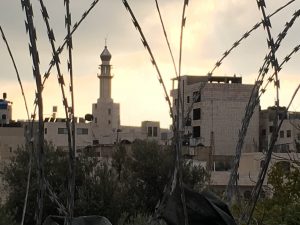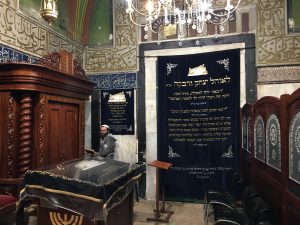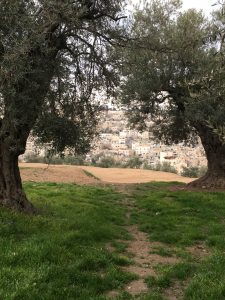My Undercover Tour of Hevron – A Weekly Letter From Rabbi Davis – January 4, 2019
Shalom Chaverim,
I just returned from two weeks in Israel and over the coming weeks would like to share some reflections on my experiences.
One of the most interesting and intense experiences was a dual narrative tour of Hevron in which I heard the perspective of both Jewish settlers and local Palestinians. The all-day tour was run by a Jerusalem hostel and attracted mostly people of other faith backgrounds. Our group of 27 represented 16 different countries from Europe to Africa, Australia to America.
 Our day began by driving from Jerusalem through the West Bank in an armored Egged bus to Hevron. There, we were given an overview of the city by our Jewish guide, Eliyahu McLain. Eliyahu had grown up in liberal Berkley before becoming ultra-orthodox. Inspired by a well know peacenick rabbi, he began these dual narrative tours. After his introduction, Eliyahu handed us off to his partner, Mohamed, who took us to the Palestinian side of town.
Our day began by driving from Jerusalem through the West Bank in an armored Egged bus to Hevron. There, we were given an overview of the city by our Jewish guide, Eliyahu McLain. Eliyahu had grown up in liberal Berkley before becoming ultra-orthodox. Inspired by a well know peacenick rabbi, he began these dual narrative tours. After his introduction, Eliyahu handed us off to his partner, Mohamed, who took us to the Palestinian side of town.
I hadn’t realized that large parts of Hevron are off limits to Jews. So, when I started to head through the Israeli security post, Mohamed told me to take off my kippa and to remain silent when the guards asked if there were any Jews in the group.
With Mohamed, we wandered around the old and new city of Hevron learning how it is divided into three areas- one that Jews control and where Jews can live, one where Palestinians live but the Israeli military controls, and one under Palestinian control where Jews may not live or enter. I am still sorting out the different laws for these different areas. But it was moving to hear Mohamed’s perspective. He is on the black list of Hamas because of his anti-Hamas Facebook posts. He is also on Israel’s black list though he is not sure why- he has never thrown stones against Israel.
 Mohamed showed us Jewish settlements in the heart of the old city and told us how settlers acquire property and expand their presence seemingly unchecked. He told us how settlers throw garbage from their second-floor apartments on Arab vendors below and go unpunished by Israeli police. He described the limitations on his movement. He has been to Jerusalem only once when he snuck in- and how he feels Israelis stereotype all Palestinians as terrorists. Finally, he invited us to his home for lunch before returning us to Eliyahu.
Mohamed showed us Jewish settlements in the heart of the old city and told us how settlers acquire property and expand their presence seemingly unchecked. He told us how settlers throw garbage from their second-floor apartments on Arab vendors below and go unpunished by Israeli police. He described the limitations on his movement. He has been to Jerusalem only once when he snuck in- and how he feels Israelis stereotype all Palestinians as terrorists. Finally, he invited us to his home for lunch before returning us to Eliyahu.
In the afternoon, we toured the small enclave of Jews protected by soldiers living in what feels like a ghost town of shuttered Palestinian shops. Most moving to me was a visit to the ancient tel of Hevron. Archaeologists are just beginning to discover the treasures of this area- mikvaot, a road from the days of Abraham, the traditional burial ground of the Bible’s Yishai and Ruth, etc. As our guide said, it is one thing to read about history. It is another to walk on the stones where it happened. Hevron was the capital of Israel for seven years before King David moved it to Jerusalem.
 Also, in the Jewish quarter, the beautiful Sephardi synagogue and the small Chabad synagogue left an impression on me. The Sephardi synagogue was established in 1540 by Jews fleeing the Spanish inquisition. The Ashkenazi synagogue was established by Chabad in 1815. These sites testify to a continuous Jewish presence in the city stretching back hundreds even thousands of years. While not denying the impact on the Palestinians, Eliyahu told stories that underscore the Jewish connection to, and right to dwell in, the city.
Also, in the Jewish quarter, the beautiful Sephardi synagogue and the small Chabad synagogue left an impression on me. The Sephardi synagogue was established in 1540 by Jews fleeing the Spanish inquisition. The Ashkenazi synagogue was established by Chabad in 1815. These sites testify to a continuous Jewish presence in the city stretching back hundreds even thousands of years. While not denying the impact on the Palestinians, Eliyahu told stories that underscore the Jewish connection to, and right to dwell in, the city.
In the Torah we are told that Isaac and Yishmael come together to bury their father Abraham in a cave in Hevron. Their descendants, Jews and Arabs, respectively, thus share an ancestor and a holy site. The cave is literally divided into Jewish and Muslim areas inaccessible from one side to the other. (ten days a year, the entire complex is accessible only to Muslims. And ten days a year, it is accessible only to Jews.)
 The tour did not provide answers or propose solutions. In fact, we were told we’d be more confused at the end than at the beginning. And indeed, we were. The purpose was simply to learn about and understand the varying perspectives and narratives: security vs occupation, rights vs restrictions, etc.
The tour did not provide answers or propose solutions. In fact, we were told we’d be more confused at the end than at the beginning. And indeed, we were. The purpose was simply to learn about and understand the varying perspectives and narratives: security vs occupation, rights vs restrictions, etc.
I can’t imagine that Abraham would be pleased with what has become of his children and the place of his burial. Appreciating and accepting each other’s claim and commitment to this place is essential if Abraham is ever to rest in peace.
L’Shalom,
Rabbi Alexander Davis
adavis@bethelsynagogue.org
On Shabbat, I’ll speak about the Beth El Family Mission to Israel followed by a post lunch discussion of Yossi Klein Halevi’s book, Letters to My Palestinian Neighbor, with Sally Abrams; Co-Director of the Speakers Bureau of the Jewish Community Relations Council (JCRC).
